Forestry/Wildlife Myths and Misconceptions
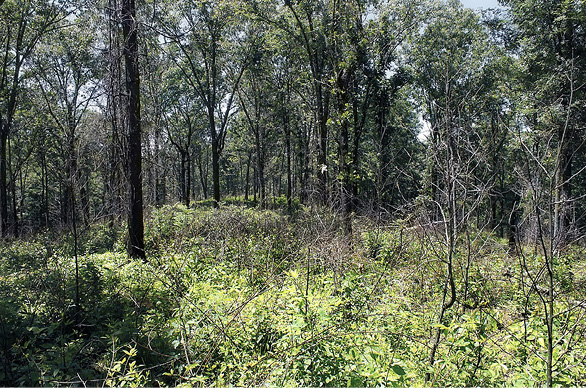
Every autumn, thousands of sportsmen head to the field to hunt their favorite game. Except for a few game species, most of this hunting is done in the forests. Mississippi’s forests provide the habitat (food and cover) our wildlife need. The better the habitat, the healthier and more plentiful the wildlife.
Forest landowners can make their forestland more productive for native wildlife, especially game species such as deer and turkey. Forests are different and are probably the most variable natural resource we have. These forests range in age, shape, size, and species composition. Consequently, since they are not the same, the habitat they provide is not the same either.
How good is the wildlife habitat on your forest land? Can you improve it? What effect do forest management practices have on your habitat? These are just a few of the questions landowners should ask themselves, especially when trying to utilize alternative sources of income during low timber markets.
Forest landowners can simultaneously improve wildlife habitat and timber quality through proper forest management. At the same time, their efforts are sometimes misdirected and work against their intended goals. Many forestry/wildlife myths and misconceptions have been passed down by misinformed individuals. These myths and misconceptions can cause forest landowners to hesitate about managing their forestland properly and serve to lower timber quality and supply.
This publication discusses some widespread myths and misconceptions about forest management. We try to replace rumor and myth with fact. Your forest resources are too valuable to be managed by hearsay. As forest landowners, we must learn scientifically proven forest-management techniques and manage forests properly.
Misconception #1: Fire is bad for wildlife.
Wildfires can be very bad for wildlife and timber, but prescribed burning in pine and some upland hardwood stands can improve wildlife habitat. Prescribed burning is the deliberate use of fire under controlled conditions to accomplish certain forestland objectives. It is one of the best wildlife habitat improvement techniques available to forest managers.
Browse plants (woody sprouts and other forage plants) soon grow beyond the reach of deer in managed pine stands. Prescribed burning at 2- to 3-year intervals keeps browse within reach of deer and stimulates growth of green, succulent plants (Figure 1). Also, fire improves the nutritional quality of deer browse for 2 to 3 years. Quail and turkey also benefit because heavy brush is removed and annual plants are encouraged to grow. Prescribed burning used with pine thinnings can dramatically improve wildlife habitat. Research has shown it can increase food for wildlife by as much as five times that found in unburned stands.
Misconception #2: Pine forests are biological deserts, and nothing is there for wildlife.
There is a common debate that hardwood stands are good for wildlife and pine stands are bad. That belief is simply not true. Either stand type can provide excellent or awful habitat under different styles of management. Approximately half of Mississippi forests are dominated by pine species, and past conversion of forests and fields to pines resulted in the belief that our wildlife habitat has been depleted across the state. In reality, much can be done in both stand types to improve wildlife habitat. Through proper forest management, pine plantations can provide good wildlife habitat and may actually provide more wildlife food for certain game species such as deer, turkey, and quail.
By now, you may be thinking of those pine plantations that are just rows of pine trees with nothing but pine needles on the forest floor (Figure 2). Pine plantations such as these have been called “biological deserts.” We have all seen them, and they definitely are not producing very much food or cover, but this situation does not and should not occur in a properly managed pine stand.
Unfortunately, the picture many see when pines are mentioned is one of dense, dark rows of pine trees. Pine plantations go through many stages. Throughout the lifespan of a pine plantation (which may vary from 30 to 60 years), wildlife habitat is constantly changing.
For the first 5 to 6 years after pines are planted, a wide assortment of grasses, forbs, and browse provide food for deer and turkeys. In this period, a pine plantation can be very productive for wildlife, especially if these young pine stands are mixed with other habitat types, such as older pine stands, hardwood stands, and pine-hardwood stands.
After this first growth period, management plays a key role. Pine crowns soon grow close together, and sunlight is shaded from the forest floor. Ultimately, the grasses, forbs, and browse plants start to disappear because they need sunlight to grow. If left unmanaged, the “biological desert” perception of pine stands results. This is where management in the form of thinnings plays an important role.
As soon as pine plantations reach pulpwood size, typically between 15 and 18 years of age, they should be marked and thinned to increase growth of residual trees and improve habitat quality. Properly thinned stands will allow production of substantial amounts of forage (Figure 2). Herbaceous plants respond to the increased sunlight and produce food for wildlife.
Regarding timber production, it may not be economically feasible, but pine stands should be thinned every 5 to 6 years to maintain production of browse plants. With today’s timber markets, repeated thinnings are often uncommon, but after three to four periodic thinnings, the stand should be ready for harvest. With careful management, over a rotation, a pine forest might only be in a state of poor habitat quality for 5 to 8 years.
To improve wildlife habitat, proper pine management must be implemented. If we manage for pine, good wildlife habitat is possible. Properly managed pine stands can and do produce very good wildlife for most of our game species.
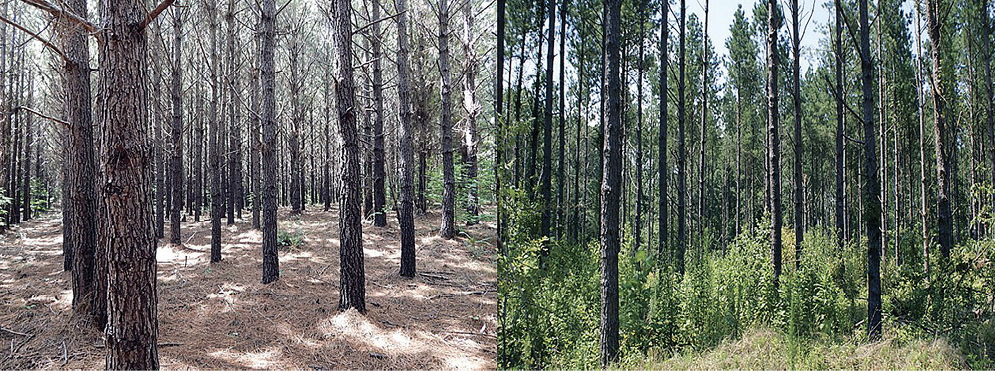
Misconception #3: All hardwoods are good for wildlife.
Are all hardwood stands good for wildlife? Not necessarily. Like unmanaged pine plantations, some hardwood stands provide little value to wildlife, although others provide tremendous benefits. In reality, all native tree species serve some beneficial role by providing food, cover, or structure for various species of wildlife. However, not all are necessarily beneficial to your targeted wildlife species of choice.
Ask yourself, “What hardwood species are beneficial, and do these hardwood species exist in my favorite hunting area?” If you are interested in deer, turkeys, or squirrels, oaks are the primary species you need to look for when evaluating a stand for hunting possibilities. Oaks produce acorns, one of our most valuable and nutritious wildlife foods. However, acorn production each year depends on two important factors:
- The age of oak trees in a hardwood forest is very important. Most species of oaks in Mississippi begin producing acorns after about 25 years. Therefore, a hardwood forest must have oak trees more than 25 years old to ensure acorn production.
- The type of oak trees is also very important. The two groups of oaks are red oaks and white oaks.
Concerning wildlife food, the major difference in red and white oaks is acorn production. White-oak acorns mature in one growing season, or every year. Red-oak acorns mature in two growing seasons and typically have both this and next year’s acorns on the tree at the same time (Figure 3). White oaks are often prolific seeders or acorn producers, but good acorn years do not occur regularly, and sometimes several years may pass without a good acorn crop (Figure 4). Red oaks are generally more reliable year-to-year acorn producers than white oaks, but production can still vary.
While there are 34 oak species native to Mississippi, some of the more beneficial red oaks are cherrybark oak, southern red oak, shumard oak, nuttall oak, willow oak, and water oak. White oak, overcup oak, and swamp chestnut oak are some of the more beneficial white oaks.
The composition of oaks in a hardwood forest does affect the dependability and size of acorn crops each year. Do white oaks, red oaks, or both grow in your favorite hardwood hunting area?
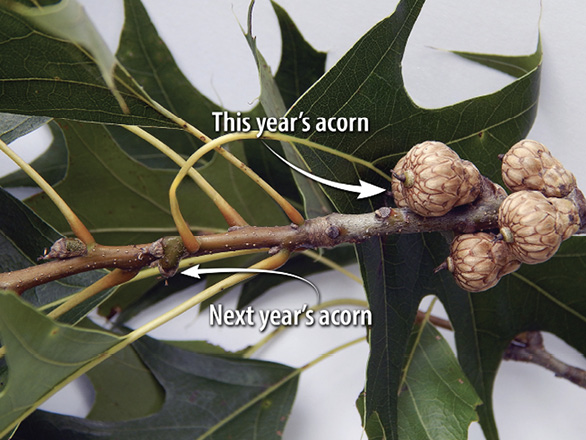
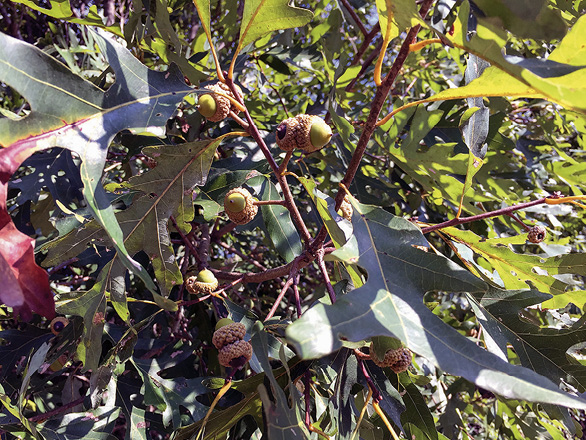
Misconception #4: Cutting only big trees leaves the younger trees room to become more valuable.
One of the statements that foresters dread hearing is, “The best way to harvest (or sell) timber is to cut the big trees and let the little ones grow.” This statement reflects the common misconception that large trees are old and small trees are young.
Larger trees are not necessarily older than small trees. In fact, often the larger trees in a stand of timber are about the same age as the small-diameter trees. The large trees are bigger because they grew faster. Prove this to yourself the next time you see a pine plantation. The diameters of trees in the plantation will vary in size from small to large, even though all were planted at the same time. This is also true in natural stands.
The rate at which a tree grows depends on species, soil fertility, competition, genetics, and other factors. It’s a mistake simply to “cut the big trees and let the little ones grow.” Often, this results in harvesting the fastest-growing trees and leaving the poorest ones.
When you harvest your timber by cutting everything larger than a specified diameter (for example, 14 inches), you are sacrificing future species composition and timber quality in that stand. This technique is called “diameter-limit cutting.” Sadly, it is one of the most common ways timber is sold and harvested in Mississippi. Many landowners have sold timber this way only to realize later the “little trees” that are left are of poor quality and unable to reseed the harvest area (Figure 5). Often the only alternatives available afterward are expensive site preparation and planting or leaving the land cut over and out of production.
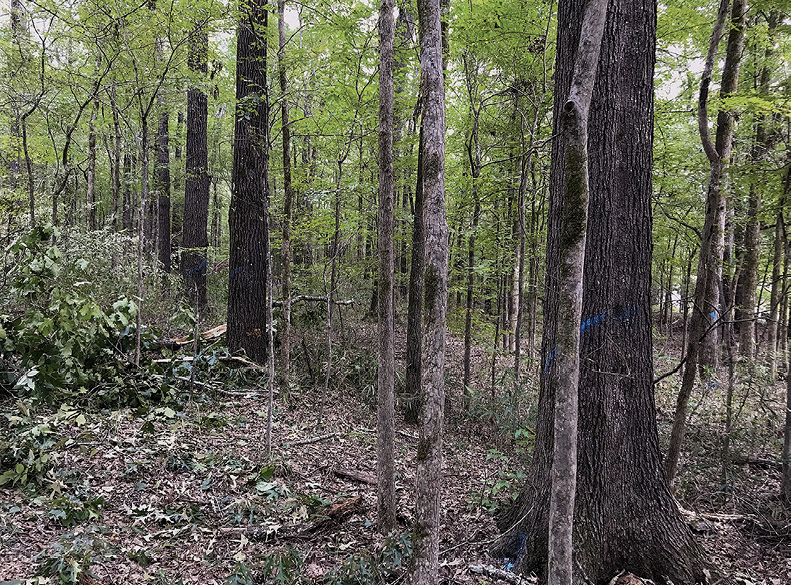
Misconception #5: Clearcutting is bad for wildlife.
Another misconception commonly encountered is that clearcutting is “bad,” not sustainable, and strips all wildlife habitat from a property. This response to clearcutting has become almost a knee-jerk reaction by many over the last 50 years. Let’s look at the facts as we consider clearcutting’s place in wildlife management.
As a starting point, let’s consider clearcuts in general. Most people think of clearcutting as the end of a forest, but foresters regard clearcutting as a way to reproduce or begin a new stand. Clearcutting is the complete removal of all trees from a designated area and is the best regeneration method for sun-loving or shade-intolerant tree species, such as southern pine and many valuable hardwood species.
Oak species are shade intolerant and must have sunlight to regenerate and grow. Sprouts or seeds from a seed source must be present for them to regenerate. Once established, they need full sunlight for best growth. Without this sunlight, oak seedlings are eventually eliminated from a stand’s makeup (Figure 6). This basic trait has resulted in a loss of oaks from hardwood forests over time.
When hardwoods were harvested in the past, and in many cases today, larger trees were cut and smaller trees were left. This is not good forest management and is also poor wildlife management. Because good oak species are shade intolerant, they usually don’t persist in hardwood understories. Therefore, when large oak trees are cut, they are often replaced by other hardwood species less valuable to both timber and wildlife habitat goals. This is why some wildlife managers recommend small clearcuts in hardwood stands. The small clearcuts provide habitat diversity, understory browse, and plant growth, and most importantly, they provide for regeneration of oak species that require open sunlight (Figure 7).
Clearcutting is a valuable management tool for foresters and wildlife managers. Many wildlife species need diversity in their habitat. That is, they need open areas, large timber, and herbaceous vegetation in their natural home range. Often, this home range is relatively small, and it is hard to find these conditions on a small area. With the proper use of clearcutting, you can maintain diversity while creating and maintaining the “edge effect,” where two of the conditions meet.
Good clearcuts for wildlife are small, irregular in shape, and well-distributed over the tract of land being managed. You can use the clearcut to maintain the diverse habitat conditions required by wildlife while practicing good forest management.
Contrary to popular belief, clearcutting does provide benefits for many of our most important game species. For rabbits and deer, an abundance of food and cover is created. Quail benefit from an influx of food, thickets for nesting, and open vegetation. Cleared areas offer turkeys open grassy areas for summer food and brood rearing, as well as brushy areas for nesting. Clearcutting, however, virtually eliminates squirrel habitat and should not be used if squirrels are the major management consideration.
If you consider the different age classes of trees on your property and properly design and execute clearcuts in terms of size and shape for maximum diversity and spacing, you will see benefits to game populations. Clearcutting is not bad for all wildlife. In fact, when done properly, it provides many positive benefits for game.
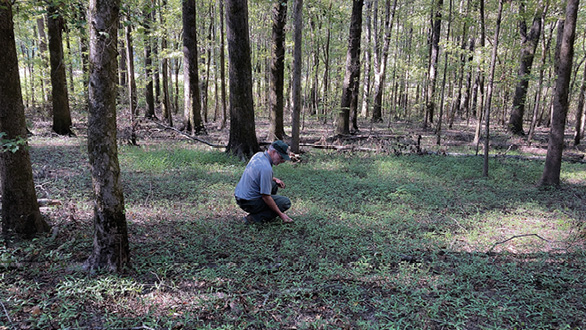
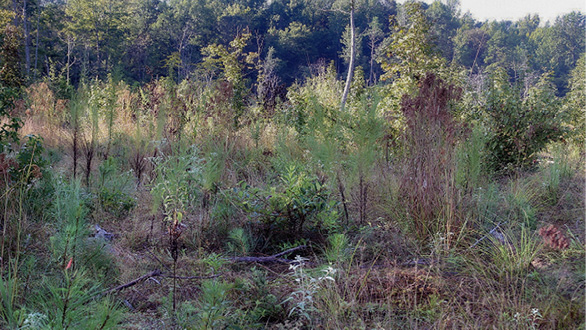
Misconception #6: All our hardwood forests are being converted to pine.
Uninformed people often make this statement. Sometimes you hear, “Timber companies are cutting all our hardwoods!”
It is true that many acres have been converted to pine from low-grade hardwoods to meet landowner and industry objectives and product demands at the time. In addition, timber industries have practiced intensive pine management over the last few decades. As of 2020, hardwoods covered approximately 45 percent of the state’s forestland (compared to 40 percent covered by pine), and this percentage has actually increased in recent decades due to hardwood establishment on former agricultural fields. Admittedly, pine forest acreage increased 20 percent between 1987 and 1994, but that is only part of the story. Hardwood acreage increased 10 percent over the same period, and overall forest acreage has increased more than 18 percent since 1938 (source: Mississippi Forestry Association).
An unrecognized culprit of hardwood losses is conversion of hardwood forests to other uses, such as agriculture, housing developments, and road construction. A glaring example of this occurred in the Mississippi Delta. Between 1957 and 1977, more than 530,000 acres of bottomland hardwoods were cleared for agricultural purposes.
Misconception #7: If you have plenty of mast-producing oaks, you don’t have to worry about providing wildlife food.
Although many species of wildlife feed on them, acorns and other mast are seasonal and sporadic. Deer, for example, depend on year-round browse for their food supply. The two basic wildlife food-producing areas in a forest are trees and the forest floor. Hardwood trees produce acorns, nuts, berries, and fruits. Plants growing under canopies produce other food sources: grasses, forbs, fruits, and browse.
Acorn production is very unpredictable. This makes it impossible to manage wildlife populations using this food source alone because it varies from year to year. In addition, acorn production depends on soil types, and good hardwood sites produce more acorns than poor sites.
Deer and other wildlife must find food year-round, and, at best, acorns are available for only a few months. Other food sources must be available to ensure healthy wildlife populations. These other food sources are normally found on the forest floor. Forest management usually enhances this food source. For example, thinning or harvesting trees allows sunlight to reach the ground. The result is a great increase in grasses, forbs, and browse on the forest floor.
Acorns and other mast are very nutritional and are beneficial to many wildlife species. However, unless other food sources are available, acorns by themselves do not provide enough food to meet the nutritional needs of most game species (Figure 8).
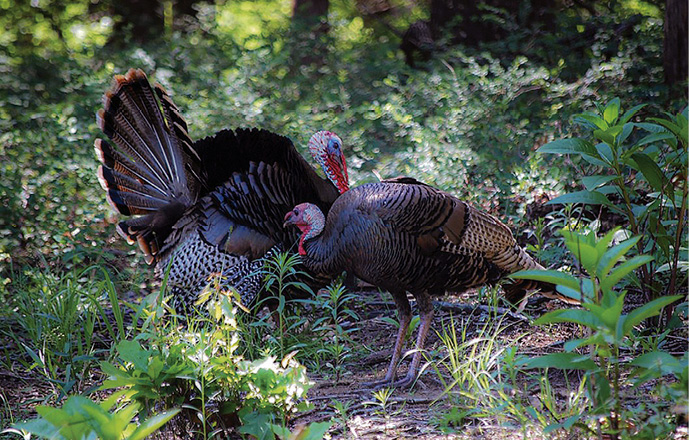
Misconception #8: We can’t manage timber and wildlife on the same acreage.
Nothing is further from the truth than this statement. Sound timber management practices create a dynamic forest habitat that can be modified to meet specific wildlife objectives. There is nothing about either management goal that excludes the other.
Thinning pine forests increases growth of future crop trees but also understory browse and plant growth for wildlife. Prescribed burning may be beneficial in timber management but is incredibly helpful in improving wildlife habitat. Fire lanes protect timber from uncontrolled fire and provide logging roads for future harvests, but they also provide good wildlife food plots if planted appropriately (Figure 9). Clearcutting timber is part of growing a crop of trees and also of beginning a new forest. If done properly, clearcuts can provide food, cover, edge, and diversity to wildlife habitat.
Good forest management, in most cases, will enhance wildlife habitat for our game species. It is not the answer to all wildlife habitat problems, but forest management and wildlife goals can be implemented on the same acreage.
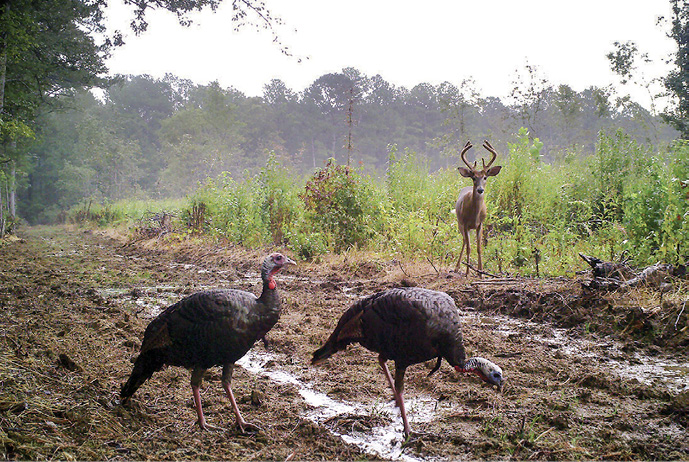
Publication 1612 (POD-6-24)
Revised by Brady Self, PhD, Extension Professor, Forestry, from an earlier version by Tim Traugott, PhD, Extension Professor Emeritus.
The Mississippi State University Extension Service is working to ensure all web content is accessible to all users. If you need assistance accessing any of our content, please email the webteam or call 662-325-2262.








